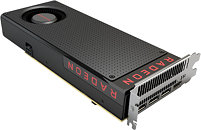- Joined
- Oct 9, 2007
- Messages
- 47,895 (7.38/day)
- Location
- Dublin, Ireland
| System Name | RBMK-1000 |
|---|---|
| Processor | AMD Ryzen 7 5700G |
| Motherboard | Gigabyte B550 AORUS Elite V2 |
| Cooling | DeepCool Gammax L240 V2 |
| Memory | 2x 16GB DDR4-3200 |
| Video Card(s) | Galax RTX 4070 Ti EX |
| Storage | Samsung 990 1TB |
| Display(s) | BenQ 1440p 60 Hz 27-inch |
| Case | Corsair Carbide 100R |
| Audio Device(s) | ASUS SupremeFX S1220A |
| Power Supply | Cooler Master MWE Gold 650W |
| Mouse | ASUS ROG Strix Impact |
| Keyboard | Gamdias Hermes E2 |
| Software | Windows 11 Pro |
With its latest Radeon Software Crimson ReLive 17.2.1 drivers, AMD decided to stop releasing regular WHQL-signed drivers for the 32-bit version of the Windows 8.1 operating system. At first we thought AMD's web-admins accidentally missed publishing the driver (so we could post it on our Downloads section). When we got in touch with AMD, we were told that the company doesn't have new drivers for 32-bit Windows 8.1. We were even told that it's because nobody cares about 32-bit Windows 8.1 anymore, citing extremely low download numbers.
Apparently, AMD is cutting down costs and time for its driver development team by discarding operating systems and architectures that only a few people use. It was first to dump Windows XP support, and support for Windows 8 (in favor of Windows 8.1). While the company does provide 64-bit Windows 8.1 WHQL drivers as regularly as its popular Windows 7 and Windows 10 ones; it is skipping support for 32-bit Windows 8.1 going forward. The company will not release any new Windows 8.1 32-bit drivers anymore. One way out of this is to upgrade to Windows 10 while you still can. Updating to Windows 10 from Windows 8.1 is pretty smooth, and maybe you can consider an upgrade to 64-bit, since most new AAA games are limited to 64-bit only.

AMD attributes the demise of its 32-bit Windows 8.1 support to the success of the Windows 10 free upgrade program, which relegated 32-bit Windows 8.1 to an extremely small install-base. Developer resources within the company were recently reallocated to focus on faster driver updates for popular operating systems, such as Windows 10 and Windows 7. The company is also consolidating its software teams to focus on a smooth Radeon Vega launch. This seems to be working, since the company recently shipped out a game release-synced driver updates faster than NVIDIA (the recent "For Honor" and "Sniper Elite 4" centric update). The company will sustain a fast driver update cadence especially after the launch of its Radeon Vega high-end graphics card line.
View at TechPowerUp Main Site
Apparently, AMD is cutting down costs and time for its driver development team by discarding operating systems and architectures that only a few people use. It was first to dump Windows XP support, and support for Windows 8 (in favor of Windows 8.1). While the company does provide 64-bit Windows 8.1 WHQL drivers as regularly as its popular Windows 7 and Windows 10 ones; it is skipping support for 32-bit Windows 8.1 going forward. The company will not release any new Windows 8.1 32-bit drivers anymore. One way out of this is to upgrade to Windows 10 while you still can. Updating to Windows 10 from Windows 8.1 is pretty smooth, and maybe you can consider an upgrade to 64-bit, since most new AAA games are limited to 64-bit only.

AMD attributes the demise of its 32-bit Windows 8.1 support to the success of the Windows 10 free upgrade program, which relegated 32-bit Windows 8.1 to an extremely small install-base. Developer resources within the company were recently reallocated to focus on faster driver updates for popular operating systems, such as Windows 10 and Windows 7. The company is also consolidating its software teams to focus on a smooth Radeon Vega launch. This seems to be working, since the company recently shipped out a game release-synced driver updates faster than NVIDIA (the recent "For Honor" and "Sniper Elite 4" centric update). The company will sustain a fast driver update cadence especially after the launch of its Radeon Vega high-end graphics card line.
View at TechPowerUp Main Site
Last edited by a moderator:




